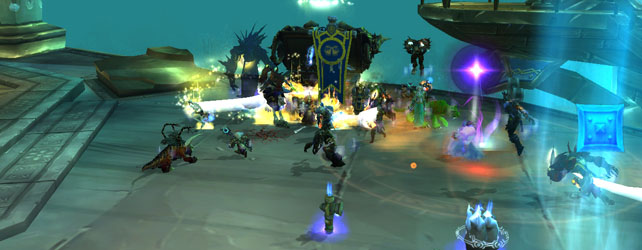I stopped raid leading a long time ago.
Who would’ve guessed that raid leading might mean a loss in ability to heal effectively? I leave that in the hands of my capable team. We’ve all made our fair share of errors and mistakes. Chances are, yours did as well. I’ve always felt that there was no reason for every player to make a mistake to learn from it. You don’t need 25 players to stand in a Void Zone to experience that it’s a bad thing to do.
So allow me to give you several fouls that I’ve committed over the years.
Pulling too fast
This is one of my biggest faults. I get pestered about trying to get pulls going too quickly. Sometimes there’s a pat coming around through a 4 pull. I’ve also been with tanks who keep pulling trash mobs even when a significant portion of the raid is down or on their way back. Generally speaking, if there’s over 5 players dead, I’ll call a stop and burn a mass resurrect followed by quick buffs before getting under way again. Keeping an eye on healer mana is important. If everyone’s fresh out of gas, give them a few seconds to replenish (I use Mana Hymns and Mana Tide totems on trash to accelerate the process).
Pulling too slow
On the other hand, you want to make sure things are going according to a schedule. There’s always time to socialize outside of raids. I used to raid with a player who flat out screamed that he was missing Blessing of Kings on trash.
Look guys, while you might wipe to trash here and there, it isn’t because you are missing Kings. Buffs can always be done on the fly. You don’t necessarily need to wait for all of your buffs to fire off before pulling.
Are there tanks present?
Are there healers present?
Is there enough DPS around?
Then it’s time to pull and let the WoW gods sort out the rest.
Not knowing when to tap out
Sometimes your raid meets a boss that they’re just presently not capable of. Maybe there’s only 15 minutes left in raid and you’ve been working on a new progression boss all night that you just killed. Now there’s a new boss standing in front of you that no one has any idea how to take on. You could always do a for fun pull and play the game of “Let’s see who survives the longest”.
Actually, where this really takes effect is around the holiday season. Maybe you don’t have enough players to field a full group. Now I dare say most raid groups can run short handed 1 or 2 players (unless you’re in 10 man). But if you suffer enough absences where it represents a significant portion of the raid, cut your losses and give everyone a night off.
Not enough sleep
Get some sleep, guys! No one likes it when a player misses a raid because they wanted to catch a quick nap and oversleep their alarm!
Makes me wish I could dock DKP for that!
Excessive consensus
Let’s be real here. If you’re raid leading, chances are you know what the hell you’re talking about more. You’ll most likely have studied up on the encounter extensively. You’ve mentally orchestrated your unit about what needs to happen. There’s generally one or two ways to take down a boss. Run that raid with a fist of steel and stick to your plan. Do not instantly agree with every new radical proposal or idea that occurs after a wipe. Stick to making minor adjustments as needed but don’t overhaul the general strategy. Chances are, your strategy is sound but the rest of the team needs to adapt and make their own individual changes to make it work.
But don’t run a raid or take on a boss in a majority rules fashion.
Too much Hand Holding
This really bothers me. It shouldn’t be the job of the raid leader to micromanage every player’s DPS rotations and individual skills. I’ve heard stories shared to me by players where their raid leader would tell a new recruit exactly what to do and when.
“Okay, Lightning Bolt… then Lava Burst … trigger your Earth Shock … Lightning Bolt again and refresh your Flame Shock.”
We try to do everything we can when it comes to recruiting applications to figure out what players know. There’s a minimum threshold of knowledge that is required. I’d say having a solid idea of how your class works and any rotations would be on the “must know” list. For other progressive guilds, knowing every ability on select hard mode bosses is a plus. Perhaps knowing how to fluently play in an off role would be a requirement. It all really depends on your guild.
Your raid leader should not be the person teaching players as they go how to play their class. Your raid leader is the guy people look to when they’re trying to figure out the overarching strategy on taking down a boss. Vik addressed the difference between a raid leader and a guild leader quite nicely last year.
Being too accommodating
There’s this great quote by Steve Jobs that I keep on my wallpaper.
“My job is to not be easy on people. My job is to make them better.”
Press the buttons that you feel will actually result in action. Don’t press buttons for the sake of pressing them. Remember that you’re in the business of raiding. Your focus and dedication is going to vary. No matter what it is, figure out what your limits are.
Someone needs a quick glass of water during a trash pull? Sure, I can live with that.
Baby just started crying right before pulling a boss and needs to be dealt with? It’s a teeth grinder and a stress ball destroyer but I’ll survive until I can get a replacement.
Need to AFK for a smoke right when you clear the last pack of trash to a new encounter? Get the hell out of my raid.
That last one especially is one of my biggest pet peeves after playing this game for so long. I’m sure it’s influenced by the fact that my dad used to smoke and I hated the smell of it. While flexibility is a great strength to have, be careful that you’re not going too far in the direction at the cost of progress.
Not pulling the trigger on decisions
Cold feet on which boss to go for?
Can’t seem to switch out the healer for the DPS?
Trouble deciding on which strategy to use?
The best raid leaders are the ones who come to a decision within a quick and reasonable amount of time. Indecision is never the right way to go. Consult with officers or other players as needed, but don’t drag your feet too much. Pick one and run with it. If you’re wrong, at least you’ll know what to do for sure next week.
One more thing
Don’t be afraid to give your raid leader feedback. Just do it after the raid is over, not during. Doing it mid raid is enough to throw them off their game which isn’t a good idea if the raid is working on some new encounters.

